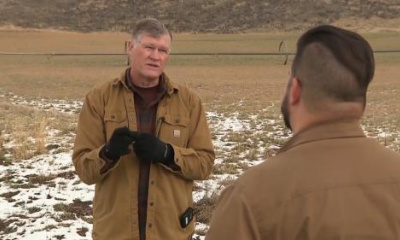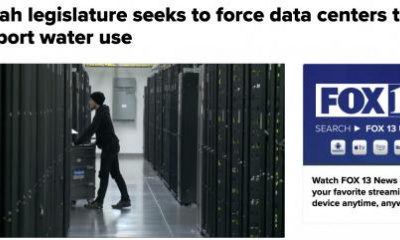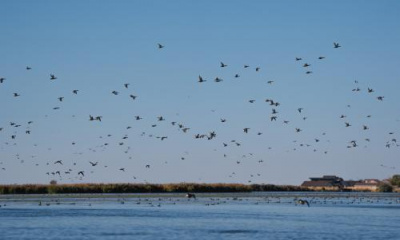Tracking saved water, wrangling with extraction companies on the menu
The popular saying that you can’t manage what you don’t measure is the underlying theme of a legislative proposal that received a unanimous endorsement Wednesday from a committee of lawmakers.
Rep. Ray Ward, R- Bountiful, is sponsoring HB448, which would set in motion a number of reporting requirements on the progress made thus far on programs designed to make more prudent use of water, including secondary metering and agricultural optimization.
Those savings would be documented by the state Division of Water Resources in coordination with the State Engineer Teresa Wilhelmsen, as well as entities such as the state Department of Agriculture and Food, the office of the Great Salt Lake Commissioner and the Colorado River Authority.
And while all eyes have been on the dwindling Great Salt Lake, this bill ropes in documentation for other critical water systems in the state, including the Colorado River Basin and the Sevier River Basin.
Rep. Rex Shipp, R-Cedar City, said that component of the bill is critical because not all water in Utah touches the Great Salt Lake.
“In my area we have an aquifer that needs to recharge,” he pointed out, adding that programs that have been put in place are helping to accomplish that.
Wilhelmsen, when asked what gains had been made so far in water savings, said it was between 50,000 and 60,000 acre-feet given the measurement protocols put in place.
“And I would also say a lot of these projects are just getting on the ground now. So in the next year or two, we’ll have a lot better data as some of these secondary metering and ag optimization (projects) and some of these others after they actually start happening, once they’re built.”
Mark Stratford, general counsel for the Jordan Valley Water Conservancy District and a member of the state water task force, stressed as well that all not efforts to save water have a direct tie to the Great Salt Lake, but that does not diminish their ecological importance.
Water banking, as an example, was developed as a strategy before the Great Salt Lake’s condition hit everyone’s radar, and other projects are designed to move water where it may be needed, he said.
Trevor Nelson, general manager of the Bear River Canal Company, pointed out, too, that the group spent $5 million on secondary metering, but it is hard to quantify any “savings” because there was not a baseline established from which to compare.
Rep. Casey Snider, R-Paradise, said the breadth and scope of the bill may mean there are asterisks or stars put after numbers contained in the required report.
“So as we’re looking at this and measuring, monitoring and reporting on water, there are some significant logistical challenges to do the thing that this report is asking of us,” he said.
“I just wanted to make sure publicly, on the record, that we are not disappointed in the first report that comes out with the post effective date on this because we do not have the tools available to achieve all of the things outlined here. Now is that built in? I think this is a very good standard to have. But I just want to put that star out there and say you might not get everything you want,” he said.
There was unanimous agreement that robust reporting of water savings and the outcome of that saved water is critical information to know, with Wilhelmsen stressing compilation of the data will help guide future planning efforts. The bill passed with no dissent out of the House Natural Resources Committee on Wednesday.
Also this week, lawmakers unanimously endorsed SB196 by Sen. Nate Blouin, D-Salt Lake City, that directs the Great Salt Lake Commissioner to come up with a “wet water year” plan for the Great Salt Lake.
The goal is to make sure in those wet water years that managers take advantage of that gift from Mother Nature to the benefit of the Great Salt Lake, which has dropped to a historic low.
The bill builds on recommendations contained in the strategic plan released by the office last month. It passed unanimously by members of the Senate Natural Resources, Agriculture and Environment Committee.
In House floor action, lawmakers gave a unanimous thumbs-up to HB453, which gives a makeover to laws regulating mineral extraction companies.
Lawmakers have previously complained about the lack of transparency among some companies at a time when everyone is being asked to cut back on water use.
Utah House Majority Leader Mike Schultz, R-Hooper, has said that Compass Minerals, operating on the north arm of the Great Salt Lake, is behaving as if it is the “wild wild West,” and it is time the company is tamed when it comes to its operations.
Snider is the sponsor of the Great Salt Lake Revisions bill.
In additional action on water-related bills, Utah Senate President Stuart Adam’s SB211 passed the Senate on a vote of 25-1 on Wednesday.
The bill is hailed as a forward-thinking measure that sets up an entity that cannot assess taxes and acts in an advisory fashion to contemplate the kind of “generational” water projects Utah will have to have in place to satisfy water needs 20 to 30 years or even longer going into the future.
Adams, R-Layton, said if not for the wisdom and foresight of the early water managers and planners, Utah would not be enjoying the kind of growth and prosperity it has now.
Sen. Kathleen Riebe, D-Cottonwood Heights, said she has received a lot of emails and other feedback regarding concerns over the measure, but she stressed her concerns have been abated with changes Adams clarified in the latest version of the bill.
“‘I’ve tried to assure people that this bill really just is an exploratory commission that has no power and I really appreciate the substitutes that illustrates what’s exactly happening here,” she added.
Sen. Scott Sandall, R-Tremonton, said the state needs to have forward thinking in place now as Utah crafts a water future moving forward.
“What’s envisioned in this bill is what is going to be necessary 20 and 30 years from now, generationally, so that our children, grandchildren and great grandchildren can have enough water and water doesn’t become the limiting factor in them being able to reside in this great state,” he said. “Without this step, all we have is ideas that just continue to circulate. We never get to a point of action.”
Blouin, who was the lone holdout in voting no to advance the measure, said he continues to have concerns about the transparency, or lack thereof, in the bill because as it establishes a state water agent to negotiate future water projects, there is no public accountability in those negotiations.
Adams has explained that potential water projects have been killed before they even start to mature because of the controversial aspect of negotiations inherent in all things water.








